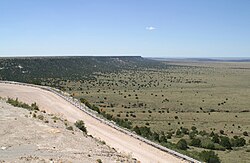Llano Estacado
| Llano Estacado | |
| "Staked Plain" | |
| Southwestern United States | |
|
Northwest escarpment of the Llano Estacado
|
|
| Country | |
|---|---|
| State | |
| Coordinates | 33°N 102°W / 33°N 102°WCoordinates: 33°N 102°W / 33°N 102°W |
| Highest point | |
| - elevation | 1,500 m (4,921 ft) |
| Lowest point | |
| - elevation | 910 m (2,986 ft) |
| Length | 400 km (249 mi) |
| Width | 240 km (149 mi) |
| Area | 97,000 km2 (37,452 sq mi) |
| Population | 1,230,000 (2013) |
|
Shaded relief image of the Llano Estacado. The escarpments marking the eastern edge of the Llano are visible, running roughly in a north–south line through the middle of the Panhandle. The western edge is on the New Mexico side of the border, with the Texas–New Mexico border running considerably closer to the western edge of the Llano than to the eastern.
|
|
Llano Estacado (Spanish pronunciation: [ˈʝano estaˈkaðo], (meaning Palisaded Plain) Texas/local pronunciation: [yano estaˈkaðo], New Mexico/local pronunciation: [ˈjano estaˈkaðo]) commonly known as the Staked Plain, is a region in the Southwestern United States that encompasses parts of eastern New Mexico and northwestern Texas. One of the largest mesas or tablelands on the North American continent, the elevation rises from 3,000 feet (900 m) in the southeast to over 5,000 feet (1,500 m) in the northwest, sloping almost uniformly at about 10 feet per mile (1.9 m/km).
The Llano Estacado lies at the southern end of the Western High Plains ecoregion of the Great Plains of North America; it is part of what was once called the Great American Desert. The Canadian River forms the Llano's northern boundary, separating it from the rest of the High Plains. To the east, the Caprock Escarpment, a precipitous cliff about 300 feet (100 m) high, lies between the Llano and the red Permian plains of Texas; while to the west, the Mescalero Escarpment demarcates the edge of the Pecos River valley. The Llano has no natural southern boundary, instead blending into the Edwards Plateau near Big Spring, Texas. This geographic area stretches about 250 miles (400 km) north to south, and 150 miles (240 km) east to west, a total area of some 37,500 square miles (97,000 km2), larger than Indiana and 12 other states. It covers all or part of 33 Texas counties and four New Mexico counties. Some years, a National Weather Service dust storm warning is issued in parts of Texas due to a dust storm originating from the area or from the adjacent lower part of the Southwestern Tablelands ecological region. The landscape is dotted by numerous small playa lakes, depressions that seasonally fill with water and provide habitat for waterfowl.
...
Wikipedia


